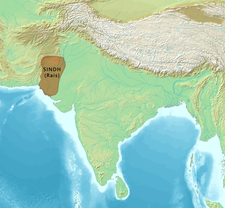This is an old revision of this page, as edited by पाटलिपुत्र (talk | contribs) at 15:55, 23 September 2022 (infobox). The present address (URL) is a permanent link to this revision, which may differ significantly from the current revision.
Revision as of 15:55, 23 September 2022 by पाटलिपुत्र (talk | contribs) (infobox)(diff) ← Previous revision | Latest revision (diff) | Newer revision → (diff) Indian queen consort| Rani Suhanadi (Sohman Devi) | |
|---|---|
| Queen consort | |
 Rani Suhanadi was an Indian queen consort of the Rai dynasty in Sindh. Rani Suhanadi was an Indian queen consort of the Rai dynasty in Sindh. | |
| Rai dynasty | |
| Reign | 7th century CE |
Rani Suhanadi (7th-century), also known as Sohman Devi, was an Indian queen consort. She was married to first Rai Sahasi II of the Rai dynasty, and secondly to Chach of Aror, Maharaja of Sindh (r. 632-671). She is known for her role in the succession of her first husband, thus establishing a new dynasty.
Life
She was first married to Rai Sahasi II. According to the traditional tale, she eventually became enamored of her husband's chancellor, Chach. Soon, she requested to be freed from a loveless (and childless) marriage, but met with Chach's rejection, arising of a desire to not incur the King's wrath and swerve further away from scriptural ideals of a Brahminic life.
Yet Chach accepted her request for providing company; they continued to meet more often and grew more close but within the accepted boundaries of social conventions. The King remained ignorant of their relationship, and Chach continued to gain unprecedented control in day-to-day affairs of the state.
Finally, after the demise of Sahasi II, Devi proposed that Chach exploit the opportunity to be the next king of Aror. Chach conceded to Devi's plan — but subject to consultation with "devoted servants" — and the news of his death was accordingly withheld when potential claimants to the throne were incited against each other in a fatal internecine warfare, that lasted a night.
In the meanwhile, ample supporters from the elites were obtained and Devi proclaimed that a "shocked" Sahasi II, though recovering quickly, was unable to hold court and had appointed Chach as the caretaker ruler for his lifetime. Gifts were lavished on important persons to win their trust on the occasion. These state of affairs continued for about six months.
Sometime afterwards, the news of his death made way to Sahasi II's brother — Rai Mahrit, then ruler of Chittor — who claimed to be the rightful heir of the throne and mounted an unsuccessful (and fatal) military offensive against Chach.
According to the traditional story, Chach, despite being ambiguous about the morality of taking on a legitimate successor, was coaxed by Devi's "shaming of his masculinity". Post-battle, Chach had all but secured the throne with him commissioning triumphal arches and public feasts; soon, Devi had him declared as the heir to the throne, being a man of "unsurmountable intellect and bravery", and went on to marry him with the approval of the court.
Legacy
Because of the role Rani Suhanadi played in the succession struggle, the Brahman dynasty was established, in what was portrayed in Chachnama, as the intrigues of a femme fatale working in conjunction with a willing-yet-ethical apprentice. He would later have to subdue protracted resistance from Bachhera, a relative of Sahasi II and the governor (or vassal) of Multan province.
Notes
- The potential claimants were asked to meet the King, who was "a bit healthy", one by one. In reality, Devi had them imprisoned only to claim before all of them that it was the King who had them imprisoned out of a quarrel with someone else. Thus, it was necessary to kill him to gain freedom and the King's trusts.
- Chach had challenged Mahrit to a one-on-one combat, claiming his Brahmin origins precluded learning the skills of cavalry. However, in the combat, Chach suddenly mounted a horse and had Mahrit beheaded. Mahrit's forces went into a disarray receiving the news of his death.
References
- ^ Asif, Manan Ahmed (2016). A Book of Conquest: The Chachnama and Muslim Origins in South Asia. Harvard University Press. pp. 65, 81–82, 131–134. ISBN 9780674660113.
- ^ Baloch, N. A., ed. (1983). Fathnamah I-Sind: Being the Original Record of the Arab Conquest of The Sind. Islamabad, Pakistan: Institute of Islamic History, Culture and Civilization: Islamic University.
- ^ Wink, Andre (1996). Al Hind: The Making of the Indo-Islamic World. BRILL. p. 133, 152-153. ISBN 90-04-09249-8.